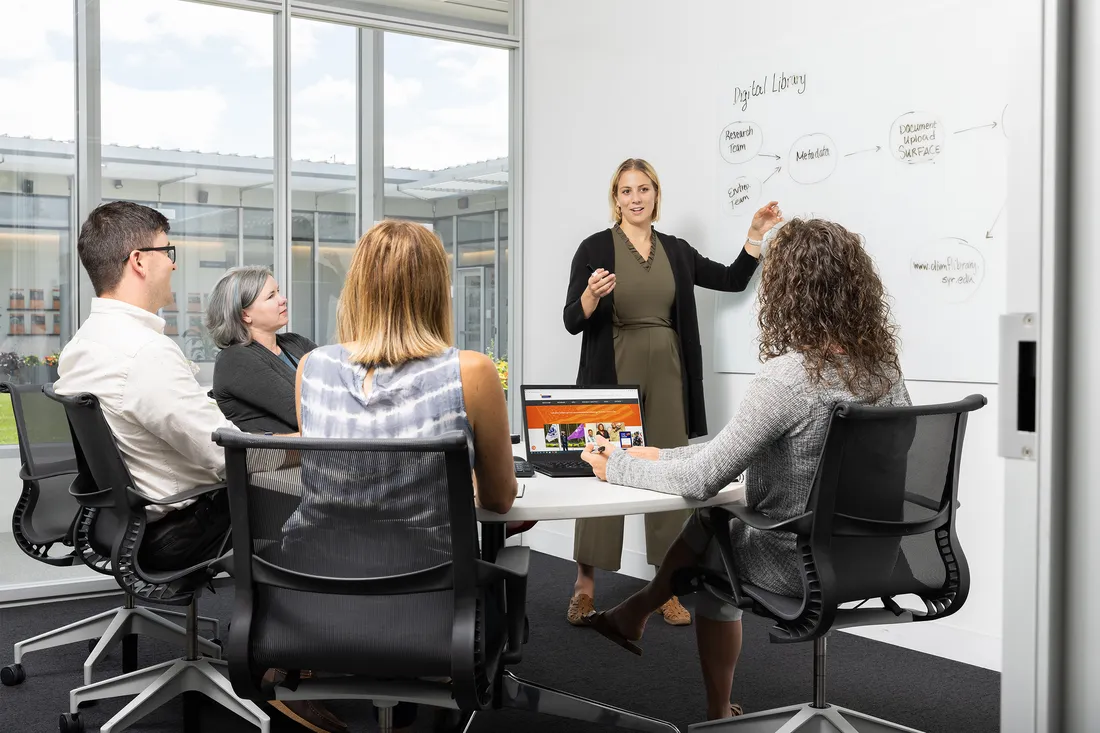
“Much of the information is practical, not theoretical,” says visiting librarian Grace “Gigi” Swinnerton G’21 (standing), who helped develop the IVMF Digital Library for students and transitioning veterans.
In the hushed, ultra-modern D’Aniello Institute for Veterans and Military Families (IVMF) at Syracuse University is the future of library technology—a testament to the ever-changing needs of today’s military-connected community.
Launched in April, the aptly named IVMF Digital Library is the first of its kind to benefit transitioning service members, veterans and their families. Bonnie Chapman Beers ’03, the IVMF’s director of evaluation and innovation, sees the virtual library as a response to the growing need for digital services and delivery models. “Consumer expectations are rapidly changing. Our veterans deserve immediate, personalized service,” she says.

The new library offers 24/7 access to IVMF-authored publications and research as well as carefully curated collections of external information.
One of the goals of the IVMF Digital Library is to provide new ways of thinking about sense of place. “Our library is everywhere and nowhere,” Beers adds. “As more collections come online, the role of the library—less as a storage space for materials and more as a 24/7 space for individual and collaborative work—takes on new significance.”
A partnership between the IVMF, Syracuse University Libraries and the School of Information Studies (iSchool), the IVMF Digital Library boasts two curated aggregations of veteran-oriented resources. One is the Employment and Economic Opportunity Collection, divided into six subcollections (e.g., “Workforce Readiness and Preparation” and “Talent Acquisition and Development”); the other is the Center of Excellence Veteran Entrepreneurship Resource Library, devoted to entrepreneurship and small business management.
Both aggregations brim with IVMF-authored publications and research as well as carefully selected collections of external research, articles and information from reputable sources.
Visiting librarian Grace “Gigi” Swinnerton G’21 estimates that more than half of the library’s 750-plus holdings are produced and curated by the IVMF. “Everything is organized with the veteran community in mind. Much of the information is practical, not theoretical,” she says.
Access to a range of materials pays big dividends for end-users, continues Swinnerton, who recorded more than 800 unique downloads during the library’s first month of operation. Tack on some 4,600 downloads of IVMF-produced content from the University’s SURFACE repository in the six months prior, and you have a page-turning success. “Content readability is key,” she adds.
Everything is organized with the veteran community in mind. Much of the information is practical, not theoretical.

Managing Data About Data
The idea for the IVMF Digital Library originated in 2019, when Beers began exploring ways to better store and manage the IVMF’s native content. “Our team is always writing and publishing case reports, so it’s important for them to be available globally and freely,” she says.
Enter Deirdre Joyce and Chad Harper G’15 of the Libraries and iSchool, respectively. They and Beers assembled a 20-member team that combined the IVMF’s locally created SURFACE content with curated external resources. The latter is presented through Quartex, the Libraries’ new, open-access digital collections management system.
Joyce, the Libraries’ head of digital stewardship, considers the purpose-built software one of the collaboration’s many benefits. “Quartex mitigated the need for a large IT staff, freeing up everyone to build out the comprehensive, descriptive metadata that drives the IVMF Digital Library,” she says.
Metadata—data about data—informs everything the team does. It’s also central to resource discovery. “Metadata defines what’s important to know about our resources and then helps us describe them in a structured, sustainable way,” Joyce continues. “It fosters worldwide use of our resources by making them more discoverable and searchable.”

“Metadata makes our resources more discoverable and searchable,” says Deirdre Joyce (left), the Libraries’ head of digital stewardship, shown here with Bonnie Chapman Beers ’03, the IVMF’s director of evaluation and innovation.
Serving Those Who Serve Us
Among those who have helped build the IVMF Digital Library is Kamryn Lenning ’24, a junior majoring in history in the Maxwell School of Citizenship and Public Affairs. For the past year, she has edited front-end content, inputted metadata and run quality assurance. “The IVMF supports the archival work I do in my degree program,” says the aspiring librarian, who recently presented her bibliothecal handiwork at the international iConference. “My greatest challenge—learning library science—is also my greatest opportunity.”
Our library is everywhere and nowhere. As more collections come online, the role of the library—less as a storage space for materials and more as a 24/7 space for individual and collaborative work—takes on new significance.
Bonnie Chapman Beers ’03
Same goes for Swinnerton, who has parlayed her experience on the project and graduate studies in library and information science into a full-time job at the University. “I often meet with vendors from Quartex, who are amazed at how we utilize their platform,” says Swinnerton, who splits time between the IVMF and the University’s Digital Library Program. “It’s exciting to use my Syracuse education to create something new and transformative.”
The IVMF Digital Library reflects the University’s scholarly mission, insists Scott Warren, the Libraries’ associate dean for research excellence. “Helping the IVMF share its scholarship globally without reinvesting in or reinventing work that the Libraries already do makes for better organization and discovery,” he says, noting that policymakers and employers, many of whom are University alumni, are among the new library’s target audiences.
Adds Beers: “The IVMF Digital Library is making a difference—serving those who serve us.”


